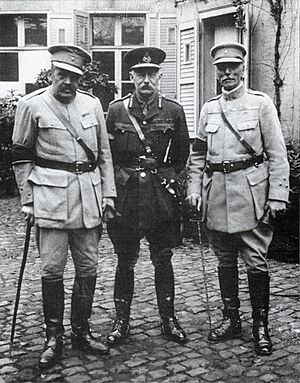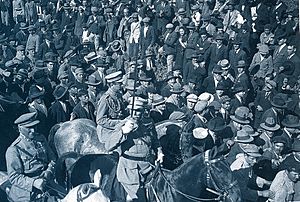Manuel Gomes da Costa facts for kids
Quick facts for kids
His Excellency Marshal
Manuel Gomes da Costa
GOA GOTE GCA
|
|
|---|---|

Gomes da Costa in 1918
|
|
| President of Portugal | |
| In office 17 June 1926 – 9 July 1926 |
|
| Preceded by | José Mendes Cabeçadas |
| Succeeded by | Óscar Carmona |
| Prime Minister of Portugal | |
| In office 17 June 1926 – 9 July 1926 |
|
| Preceded by | José Mendes Cabeçadas |
| Succeeded by | Óscar Carmona |
| Ministerial offices | |
| 1926–1926 | Acting Minister of the Interior |
| 1926–1926 | Minister of the Interior |
| 1926–1926 | Minister of War |
| 1926–1926 | Acting Minister of the Colonies |
| 1926–1926 | Minister-designate of Agriculture |
| Personal details | |
| Born |
Manuel de Oliveira Gomes da Costa
14 January 1863 Lisbon, Portugal |
| Died | 17 December 1929 (aged 66) Lisbon, Portugal |
| Political party | Independent |
| Spouse | Henriqueta Mira Godinho |
| Occupation | Military officer (General, posthumously Marshal) |
| Signature | |
| Military service | |
| Allegiance | Portuguese Second Republic |
Manuel Gomes da Costa (born January 14, 1863 – died December 17, 1929) was an important Portuguese army officer and politician. He served as the tenth President of Portugal for a short time. He was also the second leader of a new government period called the National Dictatorship.
Gomes da Costa had a long and successful career in the military. He served in Portugal's colonies like India and Mozambique from 1893 to 1915. After World War I, where he led the 1st Division of the Portuguese Expeditionary Corps, he became very involved in politics. He was against the main political party at the time, the Democratic Party.
In 1926, he played a key role in a military takeover known as the 28 May 1926 coup d'état. This event started a new, more conservative government in Portugal. After the takeover, Gomes da Costa took power from José Mendes Cabeçadas. He briefly held the positions of head of government and head of state. However, he was soon removed from power himself by another military action and replaced by Óscar Carmona.
Contents
Early Life and Education
Manuel Gomes da Costa was born in Lisbon, Portugal. His parents were Carlos Dias da Costa and Madalena de Oliveira. He had two younger sisters, Lucrécia and Amália. He started his military training at the Colégio Militar when he was just 10 years old.
Military Achievements
As a soldier, Gomes da Costa was known for his bravery and skill. He served in military campaigns in Portugal's colonies in Africa and India.
When Portugal joined World War I in early 1917, he commanded the Second Division of the Portuguese Expeditionary Corps. This was a group of Portuguese soldiers sent to fight alongside the Allies. During the Battle of the Lys on April 9, 1918, his division faced heavy fighting. Many soldiers were captured or killed.
For his leadership during the war, he was promoted to general. He also received important awards, including the Grand Officer of the Military Order of Avis. Later, he received the Grand Cross of the Military Order of Avis.
Political Role and the 1926 Revolution
Gomes da Costa believed in a monarchy, where a king or queen rules the country. Because of his strong military reputation, he was chosen by a group of right-wing revolutionaries to lead a military takeover. This event, called the 28 May 1926 coup d'état, started in Braga. It successfully ended the Portuguese First Republic, which was the government before the dictatorship.
After the revolution succeeded, Gomes da Costa did not immediately take power. Instead, he gave the roles of President and Prime Minister to José Mendes Cabeçadas. Cabeçadas had led the revolution in Lisbon. However, the other leaders of the coup soon became unhappy with Cabeçadas. They felt he was still too sympathetic to the old republic.
So, on June 17, 1926, Gomes da Costa replaced Cabeçadas in both positions. This new government was important because it included Antonio de Oliveira Salazar as finance minister. Salazar would later become a long-time dictator of Portugal.
Removal from Power and Later Life
Gomes da Costa's time in power was very short. His government lasted only about as long as Cabeçadas'. On July 9, 1926, he was removed from office by another military takeover. This new coup was led by João José Sinel de Cordes and Óscar Carmona.
Gomes da Costa was more conservative than Cabeçadas. However, he did not want to create a long-term military government. This put him in conflict with Carmona and other military leaders who wanted a more authoritarian rule. Carmona took over as President and Prime Minister, saying that Gomes da Costa was "unfit for office."
Gomes da Costa was sent away to the Azores Islands. However, he was also given the high rank of Marshal of the Portuguese Army. In September 1927, he returned to mainland Portugal. He was already very ill and passed away a few months later.
Personal Life
On May 15, 1885, Gomes da Costa married Henriqueta Júlia de Mira Godinho in Penamacor. They had three children together. His son-in-law was Pedro Francisco Massano de Amorim, who served as a governor in several Portuguese colonies.
Honours
 Grand Officer of the Order of Aviz, Portugal (February 15, 1919)
Grand Officer of the Order of Aviz, Portugal (February 15, 1919) Grand Officer of the Order of the Tower and of the Sword, of Valour, Loyalty and Merit, Portugal (September 14, 1920)
Grand Officer of the Order of the Tower and of the Sword, of Valour, Loyalty and Merit, Portugal (September 14, 1920) Grand Cross of the Order of Aviz, Portugal (October 5, 1921)
Grand Cross of the Order of Aviz, Portugal (October 5, 1921)
Images for kids
See also
- Ditadura Nacional
- Estado Novo (Portugal)
- History of Portugal
- Politics of Portugal
- Timeline of Portuguese history
- List of presidents of Portugal
- List of prime ministers of Portugal




